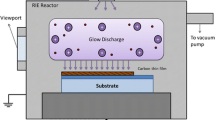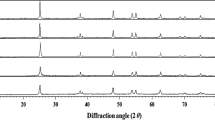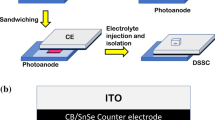Abstract
Corncob residues (CC) and sugarcane leaves (SL) are globally abundant agricultural residues. Thus, they are interesting materials for use in energy production. They were turned into carbon powders by carbonization at temperatures of 500–1100 °C under an argon atmosphere. These carbon powders were merged with a conductive polymer and covered on fluorine-doped tin oxide (FTO) glass substrates with a doctor blade for use as counter electrodes (CEs) of dye-sensitized solar cells (DSSCs). Raman spectroscopy and SEM were utilized to study the chemical composition and surface configuration of the counter electrodes. The trend of electrical conductivity and electrochemical catalytic activity improves resulting from the elevated carbonization temperature. Corncobs carbonized at 1100 °C mixed in a poly(3,4-ethylenedioxythiophene):poly(styrenesulfonate) (PEDOT:PSS, PP) (CC-PP 1100) sample provided the highest energy conversion efficiency, 5.85 ± 0.87%, against a platinum (Pt) CE (5.43 ± 0.48%) and exhibited the highest redox reaction. This is a result of the low resistivity and excellent catalytic activity of the CC-PP 1100 electrode. Moreover, this research provided the evidence of relationship between electrical conductivity and DSSC efficiency for the first time.
Graphical abstract










Similar content being viewed by others
Data availability
All data and information generated during this study are available.
References
Regan BO, Grätzel M (1991) A low-cost, high-efficiency solar cell based on dye-sensitized colloidal TiO2 films. Nature 353:737–740. https://doi.org/10.1038/353737a0
Fan B, Mei X, Sun K, Ouyang J (2008) Conducting polymer/carbon nanotube composite as counter electrode of dye-sensitized solar cells. Appl Phys Lett 93:143103. https://doi.org/10.1063/1.2996270
Yun S, Wang L, Guo W, Ma T (2012) Non-Pt counter electrode catalysts using tantalum oxide for low-cost dye-sensitized solar cells. Electrochem Commun 24:69–73. https://doi.org/10.1016/j.elecom.2012.08.008
Wu M, Lin X, Hagfeldt A, Ma T (2011) Low-cost molybdenum carbide and tungsten carbide counter electrodes for dye-sensitized solar cells, Angew Chem Int Ed 50:3520–3524. https://doi.org/10.1002/anie.201006635
Yeh MH, Lee CP, Lin LY, Nien PC, Chen PY, Vittal R, Ho KC (2011) A composite poly(3,3-diethyl-3,4-dihydro-2H-thieno-[3,4-b][1,4]-dioxepine) and Pt film as a counter electrode catalyst in dye-sensitized solar cells. Electrochim Acta 56:6157–6164. https://doi.org/10.1016/j.electacta.2011.04.028
Wu M, Lin X, Hagfeldt A, Ma T (2011) A novel catalyst of WO2 nanorod for the counter electrode of dye-sensitized solar cells. Chem Commun 47:4535–4537. https://doi.org/10.1039/C1CC10638D
Kumarasinghe KDMSPK, Kumara GRA, Rajapakse RMG, Liyanage DN, Tennakoned K (2019) Activated coconut shell charcoal based counter electrode for dye-sensitized solar cells. Org Electron 27:93–97. https://doi.org/10.1016/j.orgel.2019.05.009
Wu CS, Chang TW, Teng H, Lee YL (2016) High performance carbon black counter electrodes for dye-sensitized solar cells. Energy 115:513–518. https://doi.org/10.1016/j.energy.2016.09.052
Huang Z, Liu X, Li K, Li D, Luo Y, Li H, Song W, Chen L, Meng Q (2007) Application of carbon materials as counter electrodes of dye-sensitized solar cells. Electrochem Commun 9:596–598. https://doi.org/10.1016/j.elecom.2006.10.028
Ramasamy E, Chun J, Lee J (2010) Soft-template synthesized ordered mesoporous carbon counter electrodes for dye-sensitized solar cells. Carbon 48:4563–4565. https://doi.org/10.1016/j.carbon.2010.07.030
Yu F, Shi Y, Yao W, Hana S, Ma J (2019) A new breakthrough for graphene/carbon nanotubes as counter electrodes of dye-sensitized solar cells with up to a 10.69% power conversion efficiency. J Power Sources 412:366–373. https://doi.org/10.1016/j.jpowsour.2018.11.066
Jiang QW, Li GR, Wang F, Gao XR (2010) Highly ordered mesoporous carbon arrays from natural wood materials as counter electrode for dye-sensitized solar cells. Electrochem commun 12:924–927. https://doi.org/10.1016/j.elecom.2010.04.022
Xu S, Liu C, Wiezorek J (2018) 20 renewable biowastes derived carbon materials as green counter electrodes for dye-sensitized solar cells. Mater Chem Phys 204:294–304. https://doi.org/10.1016/j.matchemphys.2017.10.056
Wang C, Yun S, Xu H, Wang Z, Han F, Zhang Y, Si Y, Sun M (2020) Dual functional application of pomelo peel-derived bio-based carbon with controllable morphologies: an efficient catalyst for triiodide reduction and accelerant for anaerobic digestion. Ceram Int 46:3292–3303. https://doi.org/10.1016/j.ceramint.2019.10.035
Tiihonen A, Siipola V, Lahtinen K, Pajari H, Widsten P, Tamminen KT, Miettunen, (2021) Biocarbon from brewery residues as a counter electrode catalyst in dye solar cells. Electrochim Acta 368:137583. https://doi.org/10.1016/j.electacta.2020.137583
Narudin N, Ekanayake P, Soon YW, Nakajima H, Lim CM (2021) Enhanced properties of low-cost carbon black-graphite counter electrode in DSSC by incorporating binders. Sol Energy 225:237–244. https://doi.org/10.1016/j.solener.2021.06.070
Loguercio L, Matos C, Oliveira M, Marin G, Khan S, Dupont J et al (2019) Polypyrrole/ionic liquid/Au nanoparticle counter-electrodes for dye-sensitized solar cells: improving charge-transfer resistance at the CE/electrolyte interface. J Electrochem Soc 166:H3188–H3194. https://doi.org/10.1149/2.0271905jes
Mohan K, Bora A, Roy RS, Nath BC, Dolui SK (2019) Polyaniline nanotube/reduced graphene oxide aerogel as efficient counter electrode for quasi solid state dye sensitized solar cell. Sol Energy 186:360–369. https://doi.org/10.1016/j.solener.2019.05.030
Yue G, Wu J, Xiao Y, Lin J, Huang M, Fan L et al (2013) A dye-sensitized solar cell based on PEDOT:PSS counter electrode. Sci Bull 58:559–566. https://doi.org/10.1007/s11434-012-5352-3
He B, Tang Q, Liang T, Li Q (2014) Efficient dye-sensitized solar cells from polyaniline–single wall carbon nanotube complex counter electrodes. J Mater Chem A 2:3119. https://doi.org/10.1039/C3TA14167E
Lan Z, Gao S, Wu J, Lin J (2015) High-performing dye-sensitized solar cells based on reduced graphene oxide/PEDOT-PSS counter electrodes with sulfuric acid post-treatment. J Appl Polym Sci 132:42648. https://doi.org/10.1002/app.42648
Luo J, Wen HI, Wu WJ, Zhao P, Wang C, Bai XD, Wang W (2013) Enhancement of the efficiency of dye-sensitized solar cell with multi-wall carbon nanotubes/polypyrrole composite counter electrodes prepared by electrophoresis/electrochemical polymerization. Mater Res Bull 48:988–994. https://doi.org/10.1016/j.materresbull.2012.11.092
Belekoukia M, Ramasay MS, Yang S, Feng X, Paterakis G, Dracopoulos V, Galiotis C, Lianos P (2016) Electrochemically exfoliated graphene/PEDOT composite films as efficient Pt-free counter electrode for dye-sensitized solar cells. Electrochim Acta 194:110–115. https://doi.org/10.1016/j.electacta.2016.02.073
Ali GAM, Supriya S, Chong KF, Shaaban ER, Algarni H, Maiyalagan T, Hegde G (2021) Superior supercapacitance behavior of oxygen self-doped carbon nanospheres: a conversion of Allium cepa peel to energy storage system, Biomass Convers. Biorefinery 11:1311–1323. https://doi.org/10.1007/s13399-019-00520-3
Supriya S, Bhat VS, Jayeoye TJ, Rujiralai T, Chong KF, Hegde G (2021) An investigation on temperature-dependant surface properties of porous carbon nanoparticles derived from biomass. J Nanostructure Chem. https://doi.org/10.1007/s40097-021-00427-4
Mehare MD, Deshmukh AD, Dhoble SJ (2021) Bio-waste lemon peel derived carbon based electrode in perspect of supercapacitor. J Mater Sci Mater Electron 32:14057–14071. https://doi.org/10.1007/s10854-021-05985-5
Bhat VS, Krishnan SG, Jayeoye TJ, Rujiralai T, Sirimahachai U, Viswanatha R, Khalid M, Hegde G (2021) Self-activated ‘green’ carbon nanoparticles for symmetric solid-state supercapacitors. J Mater Sci 56:13271–13290. https://doi.org/10.1007/s10853-021-06154-z
Kumar DR, Kanagaraj I, Dhakal G, Prakash AS, Shim JJ (2021) Palmyra palm tree biomass-derived carbon low-voltage plateau region capacity on Na-ion battery and its full cell performance. J Environ Chem Eng 9:105698. https://doi.org/10.1016/j.jece.2021.105698
Nguyen VH, Nguyen DT, Nguyen TT, Nguyen HPT, Khuat HB et al (2021) Activated carbon with ultrahigh surface area derived from sawdust biowaste for the removal of rhodamine B in water. Environ Technol Innov 24:101811. https://doi.org/10.1016/j.eti.2021.101811
Farma R, Fadilah R, Awitdrus, Sari NK, Taer E, Saktioto, et al (2018) Corn cob based activated carbon preparation using microwave assisted potassium hydroxide activation for sea water purification. J Phys Conf Ser 1120:012017. https://doi.org/10.1088/1742-6596/1120/1/012017
Medhat A, El-Maghrabi HH, Abdelghany A, Abdel Menem NM, Raynaud P et al (2021) Efficiently activated carbons from corn cob for methylene blue adsorption. Appl Surf Sci Adv 3:100037. https://doi.org/10.1016/j.apsadv.2020.100037
Jutakanoke R, Leepipatpiboon N, Tolieng V, Kitpreechavanich V, Srinorakutara T, Akaracharanya A (2012) Sugarcane leaves: pretreatment and ethanol fermentation by Saccharomyces cerevisiae. Biomass Bioenerg 39:283–289. https://doi.org/10.1016/j.biombioe.2012.01.018
Ukkakimapan P, Ukakimaparn P, Wanchaem T, Yordsri V, Sattayarut V, Phonyiem M et al (2020) Investigation on electrochemical properties of sugarcane leaves-derived activated carbon by steam activation. Solid State Phenom 302:63–70. https://doi.org/10.4028/www.scientific.net/SSP.302.63
Tangtrakarn A, Maiaugree W, Uppachai P, Ratchapolthavisin N, Moolsarn K, Swatsitang E, Amornkitbamrung V (2019) High stability arc-evaporated carbon counter electrodes in a dye sensitized solar cell based on inorganic and organic redox mediators. Diam Relat Mater 97:107451. https://doi.org/10.1016/j.diamond.2019.107451
Kanjana N, Maiaugree W, Phitsanu P, Laokul P (2021) Synthesis and characterization of Fe-doped TiO2 hollow spheres for dye-sensitized solar cell applications. Mater Sci Eng B Solid State Mater Adv Technol 271:115311. https://doi.org/10.1016/j.mseb.2021.115311
Roh JS (2008) Structural study of the activated carbon fiber using laser Raman spectroscopy. Carbon Lett 9:127–130. https://doi.org/10.5714/CL.2008.9.2.127
Shateri-Khalilabad M, Yazdanshenas ME (2013) Preparation of superhydrophobic electroconductive graphene-coated cotton cellulose. Cellulose 20:963–972. https://doi.org/10.1007/s10570-013-9873-y
Skoog DA, Holler FJ, Nieman TA (1998) Principles of instrumental analysis. Harcourt Brace, Orlando
Lingegowda DC, Kumar JK, Deviprasad AG, Zarei M, Gopal S (2012) FTIR spectroscopic studies on cleome gynandra-comparative analysis of functional group before and after extraction, Romanian. J Biophys 22:137–143
Cha SM, Nagaraju G, Sekhar SC, Bharat LK, Yu JS (2018) Fallen leaves derived honeycomb-like porous carbon as a metal-free and low-cost counter electrode for dye-sensitized solar cells with excellent tri-iodide reduction. J Colloid Interface Sci 513:843–851. https://doi.org/10.1016/j.jcis.2017.11.080
Zhang Y, Yun S, Wang C, Wang Z, Han F, Si Y (2019) Bio-based carbon-enhanced tungsten-based bimetal oxides as counter electrodes for dye-sensitized solar cells. J Power Sources 423:339–348. https://doi.org/10.1016/j.jpowsour.2019.03.054
Wang G, Wang D, Kuang S, Xing W, Zhuo S (2014) Hierarchical porous carbon derived from rice husk as a low-cost counter electrode of dye-sensitized solar cells, Renew. Energy 63:708–714. https://doi.org/10.1016/j.renene.2013.10.033
Nagaraju G, Lim JH, Cha SM, Yu JS (2017) Three-dimensional activated porous carbon with meso/macropore structures derived from fallen pine cone flowers: a low-cost counter electrode material in dye-sensitized solar cells. J Alloys Compd 693:1297–1304. https://doi.org/10.1016/j.jallcom.2016.10.015
Sarker S, Ahammad AJS, Seo HW, Kim DM (2014) Electrochemical impedance spectra of dye-sensitized solar cells: fundamentals and spreadsheet calculation. Int J Photoenergy 2014:1–17. https://doi.org/10.1155/2014/851705
Hu Q, Wu C, Cao L, Pu J, Jian L (2013) A novel TiO2 nanowires/nanoparticles composite photoanode with SrO shell coating for high performance dye-sensitized solar cell. J Power Sources 226:8–15. https://doi.org/10.1016/j.jpowsour.2012.10.066
Duong TT, Choi HJ, He QJ, Le AT, Yoon SG (2013) Enhancing the efficiency of dye sensitized solar cells with an SnO2 blocking layer grown by nanocluster deposition. J Alloys Compd 561:206–210. https://doi.org/10.1016/j.jallcom.2013.01.188
Han L, Koide N, Chiba Y, Mitate T (2004) Modeling of an equivalent circuit for dye-sensitized solar cells. Appl Phys Lett 84:2433–2435. https://doi.org/10.1016/j.crci.2005.02.046
Kern R, Sastrawan R, Ferber J, Stangl R, Luther J (2002) Modeling and interpretation of electrical impedance spectra of dye solar cells operated under open-circuit conditions. Electrochim Acta 47:4213–4225. https://doi.org/10.1016/S0013-4686(02)00444-9
Li CT, Lee CT, Li SR, Lee CP, Chiu IT et al (2016) Composite films of carbon black nanoparticles and sulfonated-polythiophene as flexible counter electrodes for dye-sensitized solar cells. J Power Sources 302:155–163. https://doi.org/10.1016/j.jpowsour.2015.10.028
Wachter P, Zistler M, Schreiner C, Berginc M, Krasovec UO, Gerhard D, Wasserscheid P, Hinsch A, Gores HJ (2008) Characterisation of DSSC-electrolytes based on 1-ethyl-3-methylimidazolium dicyanamide measurement of triiodide diffusion coefficient, viscosity, and photovoltaic performance. J Photochem Photobiol A 197:25–33. https://doi.org/10.1016/j.jphotochem.2007.12.001
Adachi M, Sakamoto M, Jiu J, Ogata Y, Isoda S (2006) Determination of parameters of electron transport in dye-sensitized solar cells using electrochemical impedance spectroscopy. J Phys Chem B 110:13872–13880. https://doi.org/10.1021/jp061693u
Acknowledgements
Financial support for this research was provided by the Thailand Science Research and Innovation (TSRI) 2021. This research project was financially supported by the Mahasarakham University and Thammasat University, Thailand. The Post-doctoral Program from Research Affairs and the Graduate School, Khon Kaen University (Grant No. 60166), Khon Kaen University, Thailand, funded a scholarship supporting this study.
Funding
This work was supported by the Thailand Science Research and Innovation (TSRI) 2021, and The Post-doctoral Program from Research Affairs and the Graduate School, Khon Kaen University (Grant No. 60166), Khon Kaen University, Thailand, are hereby deeply regarded for financially supporting this research.
Author information
Authors and Affiliations
Contributions
Nattakan Kanjana and Wasan Maiaugree did all the experimental work, collected the data, designed the visualization, and drafted the initial paper. Paveena Laoku, Artit Chingsungnoen, Inthira Chaiya, and Sujittra Daengsakul designed the study and provided resources. Wasan Maiaugree, Sarawut Tontapha, Samuk Pimanpang, and Vittaya Amornkitbumrung supervised the study, provided resources, and supported in acquiring funding. All the authors read the manuscript prior to submission, contributed to the writing-review, and editing of the manuscript.
Corresponding author
Ethics declarations
Conflict of interest
The authors declare no competing interests.
Additional information
Publisher's note
Springer Nature remains neutral with regard to jurisdictional claims in published maps and institutional affiliations.
Supplementary Information
Below is the link to the electronic supplementary material.
Rights and permissions
About this article
Cite this article
Kanjana, N., Maiaugree, W., Tontapha, S. et al. Effect of carbonization temperature on the electrocatalytic property and efficiency of dye-sensitized solar cells derived from corncob and sugarcane leaf agricultural residues. Biomass Conv. Bioref. 13, 8361–8371 (2023). https://doi.org/10.1007/s13399-021-02204-3
Received:
Revised:
Accepted:
Published:
Issue Date:
DOI: https://doi.org/10.1007/s13399-021-02204-3




